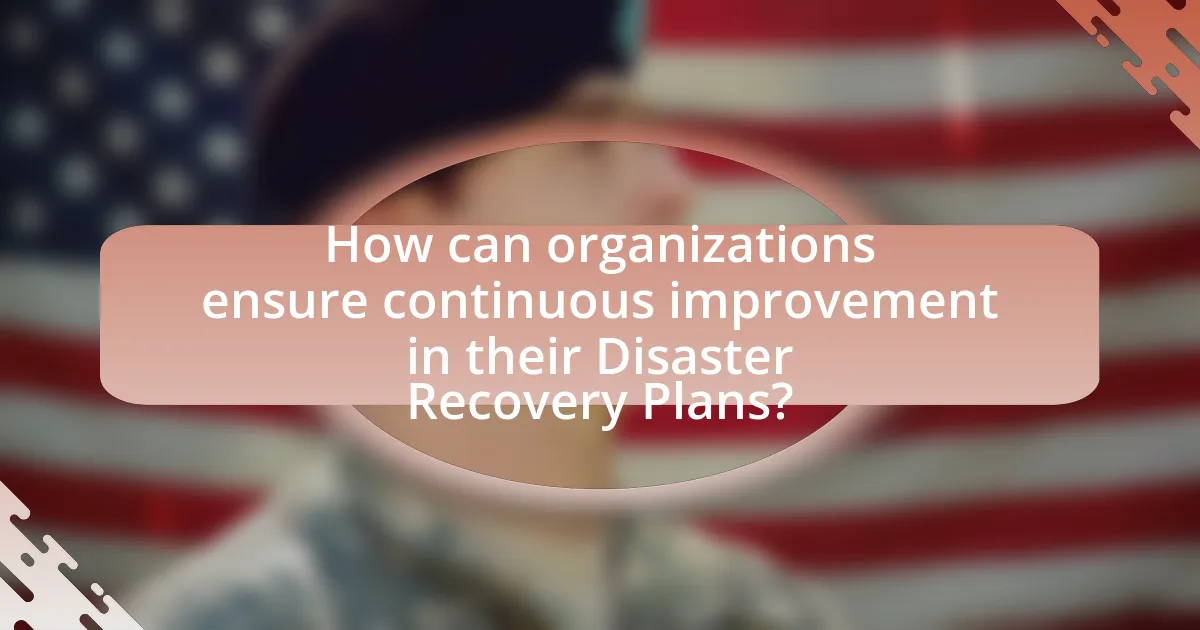Disaster Recovery Plans (DRPs) in Cloud Hosting are essential strategies that ensure the recovery and continuity of cloud services following disruptive events. These plans encompass data backup procedures, failover processes, and recovery time objectives, which are vital for minimizing downtime and data loss. The article outlines the significance of DRPs, the risks they mitigate, and how they differ from traditional backup solutions. It also details the key components of effective DRPs, the role of data backup, and the importance of regular testing. Additionally, it discusses best practices for implementation, the advantages of a multi-cloud approach, and common challenges organizations face in disaster recovery planning.

What are Disaster Recovery Plans in Cloud Hosting?
Disaster Recovery Plans in Cloud Hosting are structured strategies designed to ensure the recovery and continuation of cloud services after a disruptive event. These plans typically include data backup procedures, failover processes, and recovery time objectives, which are critical for minimizing downtime and data loss. According to a report by the International Data Corporation, 70% of organizations that experience a significant data loss fail within a year, highlighting the importance of having a robust disaster recovery plan in place.
Why are Disaster Recovery Plans essential for cloud hosting?
Disaster Recovery Plans are essential for cloud hosting because they ensure business continuity and data protection in the event of unexpected disruptions. These plans provide a structured approach to recover and restore IT systems, minimizing downtime and data loss. According to a study by the Disaster Recovery Preparedness Council, 70% of organizations without a disaster recovery plan experience significant data loss during a disaster, highlighting the critical need for such strategies in cloud environments.
What risks do Disaster Recovery Plans mitigate in cloud environments?
Disaster Recovery Plans (DRPs) mitigate several risks in cloud environments, including data loss, service outages, and security breaches. By implementing DRPs, organizations ensure that critical data is backed up and can be restored quickly, minimizing downtime and maintaining business continuity. For instance, a study by the Disaster Recovery Preparedness Council found that 60% of organizations without a DRP experienced significant data loss during outages, highlighting the importance of having a structured recovery strategy in place. Additionally, DRPs help address compliance risks by ensuring that data recovery processes meet regulatory requirements, thereby protecting organizations from potential legal penalties.
How do Disaster Recovery Plans differ from traditional backup solutions?
Disaster Recovery Plans (DRPs) differ from traditional backup solutions primarily in their scope and objectives. DRPs encompass a comprehensive strategy for restoring IT systems and business operations after a disaster, including detailed procedures for data recovery, system restoration, and continuity of operations. In contrast, traditional backup solutions focus mainly on data preservation, typically involving periodic copies of data stored offsite or in the cloud without addressing the broader operational recovery needs.
For instance, a DRP includes not only data recovery but also plans for hardware replacement, communication strategies, and employee roles during a disaster, ensuring that the entire organization can resume normal operations efficiently. According to a study by the Disaster Recovery Preparedness Council, 70% of organizations without a DRP fail within a year of a major disaster, highlighting the critical importance of having a structured recovery plan beyond mere data backup.
What are the key components of an effective Disaster Recovery Plan?
The key components of an effective Disaster Recovery Plan include risk assessment, recovery strategies, communication plan, data backup procedures, and regular testing. Risk assessment identifies potential threats and vulnerabilities, allowing organizations to prioritize their recovery efforts. Recovery strategies outline specific actions to restore operations, including alternative site arrangements and resource allocation. A communication plan ensures that all stakeholders are informed during a disaster, facilitating coordination and response. Data backup procedures detail how and where data is stored, ensuring its availability for recovery. Regular testing of the plan verifies its effectiveness and identifies areas for improvement, which is crucial for maintaining readiness.
What role does data backup play in a Disaster Recovery Plan?
Data backup is a critical component of a Disaster Recovery Plan as it ensures the preservation and restoration of essential data following a disruptive event. In the context of disaster recovery, data backups provide a reliable means to recover lost information, minimizing downtime and operational impact. According to a study by the Ponemon Institute, 70% of organizations that experience a significant data loss fail within a year, highlighting the importance of having robust data backup strategies in place. By regularly backing up data, organizations can quickly restore their systems to a functional state, thereby maintaining business continuity and protecting against data loss due to disasters such as cyberattacks, hardware failures, or natural disasters.
How do recovery time objectives (RTO) and recovery point objectives (RPO) influence planning?
Recovery Time Objectives (RTO) and Recovery Point Objectives (RPO) significantly influence disaster recovery planning by establishing the maximum acceptable downtime and data loss, respectively. RTO defines the target time to restore services after a disruption, guiding resource allocation and recovery strategies to minimize operational impact. RPO specifies the maximum age of data that can be lost, informing backup frequency and data replication methods to ensure data integrity. For instance, a business with an RTO of four hours and an RPO of one hour must implement solutions that enable quick recovery and frequent data backups, thus shaping the overall disaster recovery framework.
How can organizations assess their Disaster Recovery needs?
Organizations can assess their Disaster Recovery needs by conducting a Business Impact Analysis (BIA) to identify critical functions and the potential impact of disruptions. This analysis helps organizations prioritize recovery efforts based on the importance of various operations and the acceptable downtime for each. Additionally, organizations should evaluate their current IT infrastructure, including data backup solutions and recovery time objectives (RTO), to ensure they align with business requirements. According to a study by the Disaster Recovery Preparedness Council, 70% of organizations that conduct a BIA report improved recovery strategies, demonstrating the effectiveness of this approach in identifying and addressing disaster recovery needs.
What factors should be considered when evaluating potential risks?
When evaluating potential risks in disaster recovery plans for cloud hosting, factors such as data integrity, system availability, compliance requirements, and recovery time objectives must be considered. Data integrity ensures that information remains accurate and uncorrupted during recovery processes, while system availability assesses the uptime and accessibility of cloud services. Compliance requirements involve adhering to legal and regulatory standards relevant to data protection and privacy. Recovery time objectives define the maximum acceptable downtime, guiding the urgency and effectiveness of the recovery strategy. These factors collectively inform a comprehensive risk assessment, ensuring that disaster recovery plans are robust and effective.
How can businesses determine their critical applications and data?
Businesses can determine their critical applications and data by conducting a thorough business impact analysis (BIA) that identifies essential functions and the data required to support them. This process involves assessing the potential impact of disruptions on operations, which helps prioritize applications and data based on their importance to business continuity. According to a study by the Disaster Recovery Preparedness Council, organizations that perform regular BIAs are 50% more likely to have effective disaster recovery plans in place, underscoring the significance of this analysis in identifying critical resources.

What are the best practices for implementing Disaster Recovery Plans in Cloud Hosting?
The best practices for implementing Disaster Recovery Plans in Cloud Hosting include conducting a thorough risk assessment, defining recovery objectives, and regularly testing the plan. A risk assessment identifies potential threats and vulnerabilities, ensuring that the plan addresses the most critical areas. Defining recovery time objectives (RTO) and recovery point objectives (RPO) establishes clear goals for how quickly and how much data can be recovered after a disaster. Regular testing of the disaster recovery plan, including simulations and updates, ensures that the plan remains effective and that all stakeholders are familiar with their roles. According to a study by the Disaster Recovery Preparedness Council, organizations that regularly test their disaster recovery plans are 50% more likely to recover successfully from a disaster.
How should organizations prioritize their recovery strategies?
Organizations should prioritize their recovery strategies by assessing critical business functions and identifying the potential impact of disruptions. This involves conducting a business impact analysis (BIA) to determine which processes are essential for operational continuity and the acceptable downtime for each. For instance, a study by the Disaster Recovery Institute International indicates that 70% of organizations that experience a significant data loss go out of business within a year, highlighting the importance of prioritizing recovery efforts based on risk assessment and business needs. By focusing on the most critical functions first, organizations can allocate resources effectively and ensure a more resilient recovery process.
What are the advantages of a multi-cloud approach for disaster recovery?
A multi-cloud approach for disaster recovery offers enhanced resilience, flexibility, and cost-effectiveness. By utilizing multiple cloud service providers, organizations can mitigate the risk of downtime associated with a single vendor failure, ensuring that critical applications remain operational. This strategy allows for optimized resource allocation, as businesses can select the best services from different providers based on performance and pricing. Additionally, a multi-cloud setup can improve data redundancy and backup options, as data can be stored across various locations, reducing the likelihood of data loss. According to a report by Gartner, organizations that adopt a multi-cloud strategy can achieve up to 30% cost savings on their cloud expenditures while improving their disaster recovery capabilities.
How can regular testing improve the effectiveness of a Disaster Recovery Plan?
Regular testing enhances the effectiveness of a Disaster Recovery Plan by identifying weaknesses and ensuring that recovery procedures function as intended. Through consistent simulations of disaster scenarios, organizations can evaluate their response times, resource allocation, and communication protocols. For instance, a study by the Disaster Recovery Institute International found that organizations that conduct regular testing are 50% more likely to recover from disruptions within their targeted recovery time objectives. This empirical evidence underscores the importance of testing in refining processes and improving overall resilience.
What tools and technologies support Disaster Recovery in cloud environments?
Tools and technologies that support Disaster Recovery in cloud environments include backup and recovery solutions, replication technologies, and orchestration tools. Backup and recovery solutions, such as Veeam and Acronis, enable data to be backed up and restored efficiently. Replication technologies, like AWS Elastic Block Store and Azure Site Recovery, ensure that data is continuously replicated to a secondary location for quick recovery. Orchestration tools, such as VMware Site Recovery Manager, automate the recovery process, reducing downtime and manual intervention. These tools collectively enhance the resilience and reliability of cloud-based disaster recovery strategies.
What are the most popular cloud-based disaster recovery solutions available?
The most popular cloud-based disaster recovery solutions available include VMware Cloud Disaster Recovery, Microsoft Azure Site Recovery, and AWS Elastic Disaster Recovery. VMware Cloud Disaster Recovery offers a scalable and cost-effective solution that integrates with existing VMware environments, allowing for rapid recovery of virtual machines. Microsoft Azure Site Recovery automates the replication of on-premises workloads to Azure, ensuring minimal downtime and quick failover capabilities. AWS Elastic Disaster Recovery provides continuous replication of applications to AWS, enabling quick recovery and reducing the complexity of disaster recovery processes. These solutions are widely recognized for their reliability and effectiveness in maintaining business continuity during disruptions.
How do automation and orchestration enhance disaster recovery processes?
Automation and orchestration enhance disaster recovery processes by streamlining recovery tasks and reducing human error. Automation allows for predefined recovery actions to be executed without manual intervention, ensuring that critical systems are restored quickly and consistently. Orchestration coordinates these automated tasks across various systems and platforms, enabling a cohesive recovery strategy that minimizes downtime. For instance, a study by the Disaster Recovery Journal found that organizations implementing automated disaster recovery solutions experienced a 50% reduction in recovery time compared to manual processes. This efficiency not only accelerates recovery but also improves overall resilience against future disruptions.
What common challenges do organizations face in Disaster Recovery planning?
Organizations face several common challenges in Disaster Recovery planning, including inadequate risk assessment, insufficient budget allocation, and lack of employee training. Inadequate risk assessment often leads to overlooking critical vulnerabilities, which can result in ineffective recovery strategies. Insufficient budget allocation restricts the ability to invest in necessary technologies and resources, hindering the overall effectiveness of the disaster recovery plan. Additionally, a lack of employee training can result in unpreparedness during actual disaster scenarios, as staff may not be familiar with recovery procedures. According to a 2021 survey by the Disaster Recovery Preparedness Council, 60% of organizations reported that their disaster recovery plans were not adequately tested, highlighting the importance of addressing these challenges for effective disaster recovery.
How can organizations overcome budget constraints in disaster recovery?
Organizations can overcome budget constraints in disaster recovery by prioritizing cost-effective strategies such as leveraging cloud-based solutions, which typically offer scalable resources and pay-as-you-go pricing models. By utilizing cloud services, organizations can reduce the need for significant upfront investments in hardware and infrastructure, allowing them to allocate funds more efficiently. Additionally, implementing a tiered recovery approach enables organizations to focus on critical systems first, optimizing resource allocation based on business impact. Research indicates that 70% of organizations that adopt cloud-based disaster recovery solutions report reduced costs compared to traditional methods, demonstrating the financial benefits of this approach.
What are the implications of regulatory compliance on Disaster Recovery Plans?
Regulatory compliance significantly influences Disaster Recovery Plans (DRPs) by mandating specific protocols and standards that organizations must follow to ensure data protection and business continuity. Compliance frameworks, such as GDPR, HIPAA, and PCI-DSS, require organizations to implement robust data recovery strategies that include regular backups, data encryption, and access controls. For instance, HIPAA mandates that healthcare organizations must have contingency plans that include data recovery procedures to protect patient information, thereby directly impacting the design and execution of DRPs. Failure to adhere to these regulations can result in severe penalties, including fines and legal repercussions, emphasizing the necessity for organizations to align their DRPs with regulatory requirements to mitigate risks and ensure operational resilience.

How can organizations ensure continuous improvement in their Disaster Recovery Plans?
Organizations can ensure continuous improvement in their Disaster Recovery Plans by regularly conducting risk assessments and updating their strategies based on evolving threats and business needs. This proactive approach allows organizations to identify vulnerabilities and adapt their recovery processes accordingly. For instance, a study by the Disaster Recovery Institute International found that organizations that conduct annual reviews of their disaster recovery plans are 50% more likely to recover successfully from disruptions. Additionally, incorporating lessons learned from previous incidents and conducting regular training and simulations can further enhance the effectiveness of these plans.
What metrics should be tracked to evaluate Disaster Recovery effectiveness?
To evaluate Disaster Recovery effectiveness, organizations should track metrics such as Recovery Time Objective (RTO), Recovery Point Objective (RPO), and the success rate of recovery tests. RTO measures the maximum acceptable time to restore services after a disaster, while RPO indicates the maximum acceptable amount of data loss measured in time. Tracking these metrics allows organizations to assess their preparedness and response capabilities. For instance, a study by the Disaster Recovery Preparedness Council found that 70% of organizations that regularly test their RTO and RPO metrics report higher confidence in their disaster recovery plans.
How can feedback loops enhance the Disaster Recovery planning process?
Feedback loops enhance the Disaster Recovery planning process by facilitating continuous improvement and adaptation of recovery strategies. These loops allow organizations to gather data from past incidents, analyze the effectiveness of their recovery efforts, and make informed adjustments to their plans. For instance, a study by the National Institute of Standards and Technology (NIST) emphasizes that iterative feedback mechanisms can lead to more resilient recovery frameworks by incorporating lessons learned from real-world scenarios. This iterative process ensures that disaster recovery plans remain relevant and effective in the face of evolving threats and changing organizational needs.
What are the key takeaways for developing a robust Disaster Recovery Plan?
Key takeaways for developing a robust Disaster Recovery Plan include conducting a thorough risk assessment, establishing clear recovery objectives, and regularly testing the plan. A risk assessment identifies potential threats and vulnerabilities, enabling organizations to prioritize resources effectively. Setting recovery time objectives (RTO) and recovery point objectives (RPO) ensures that critical systems can be restored within acceptable timeframes. Regular testing of the plan, including simulations and updates, is essential to ensure its effectiveness and to adapt to changing circumstances. These practices are supported by industry standards, such as the National Institute of Standards and Technology (NIST) guidelines, which emphasize the importance of preparedness and continuous improvement in disaster recovery strategies.
What steps should organizations take to regularly update their Disaster Recovery Plans?
Organizations should conduct regular reviews and updates of their Disaster Recovery Plans (DRPs) to ensure effectiveness and relevance. This process involves assessing changes in business operations, technology, and potential threats. Specifically, organizations should schedule biannual reviews of their DRPs, incorporate lessons learned from any incidents or drills, and ensure alignment with current regulatory requirements. Additionally, organizations must engage stakeholders from various departments to gather insights and validate the plan’s applicability. Regular testing of the DRP through simulations or tabletop exercises is crucial to identify gaps and improve response strategies. These steps are validated by industry standards, such as the National Institute of Standards and Technology (NIST) guidelines, which emphasize the importance of continuous improvement in disaster recovery planning.
How can organizations educate their teams about Disaster Recovery best practices?
Organizations can educate their teams about Disaster Recovery best practices through structured training programs and regular simulations. Implementing comprehensive training sessions that cover key concepts, roles, and responsibilities in disaster recovery ensures that all team members understand their part in the process. Additionally, conducting regular disaster recovery drills helps reinforce these practices by providing hands-on experience in responding to simulated incidents. Research indicates that organizations with regular training and simulation exercises experience a 30% improvement in recovery time objectives (RTO) compared to those without such practices. This evidence underscores the importance of continuous education and practical application in mastering disaster recovery strategies.


